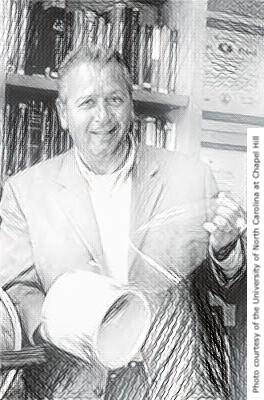Joseph DeSimone
The massive, daily demand for solvents necessary for typical manufacturing and industrial processes used across the planet mean that sadly, after use, many of these often toxic substances are leaked back into our environment. From automotive and electronics manufacturing to water, paper, mining, and cleaning industries, enormous amounts of these substances tax our water supplies and all too often lead to contamination of our ground water and ecosystems.
Polymer chemist Joseph M. DeSimone has made a number of groundbreaking advances with the aim of curbing these effects through “dry,” carbon dioxide-based alternatives. His inventions, which are already being used in a variety of industries in the U.S. and abroad, are just beginning to make an impact and could lead to outstanding, positive effects on the environment in the future.
Born in Norristown, Pa., on May 16, 1964, DeSimone earned a BS in Chemistry from Ursinus College followed by a PhD in Chemistry from Virginia Polytechnic Institute and State University. Upon completion of his studies, he joined the University of North Carolina (UNC) at Chapel Hill as an assistant professor in chemistry and launched the university’s polymer program with his mentor, Dr. Edward Samulski. He resides in Chapel Hill as the Chancellor’s Eminent Professor of Chemistry at UNC and the William R. Kenan, Jr. Distinguished Professor of Chemical Engineering at North Carolina State University.
Among DeSimone’s notable inventions is an environmentally friendly manufacturing process that relies on carbon dioxide instead of water and bio-persistent surfactants (detergents) for the creation of fluoropolymers or high-performance plastics. As of 1992, Dupont is using DeSimone’s technology to manufacture one such plastic, Teflon®.
DeSimone’s research has also enabled the utility of CO2 into separation and cleaning applications, for such uses as precision cleaning in microelectronics and in the dry cleaning industry. Traditionally, dry cleaners use a hazardous chlorinated solvent known as perchloroethylene, or perc, a ground contaminant and probable human carcinogen. DeSimone’s use of liquid CO2 provides for a pollution-free alternative to perc that has been lauded by those in the industry and the press, including Consumer Reports and the Sierra Club. The company DeSimone founded in 1995 to commercialize his inventions, Micell Technologies, spawned a dry cleaning franchise called Hanger’s Cleaners that uses his CO2 methods. Today, over 60 stores are in operation in the U.S. and Canada.
DeSimone and his team research ways to commercialize CO2-based technologies for cleaning, drying, coating, and etching processes used to make integrated circuits in the microelectronics industry. Currently, a typical plant processing 40,000 silicon wafers per month uses several million gallons of water per day.
DeSimone worked on a team to design a polymer-based, fully bioabsorbable, drug-eluting stent, which helps keep a blocked blood vessel open after a balloon-angioplasty and is absorbed by the body within 18 months. His invention, PRINT® (Particle Replication in Non-wetting Templates) technology, is used to manufacture nanocarriers in medicine. DeSimone’s lab is also vested in projects involving applications for more efficient solar cells and morphable robots.
In 2004, DeSimone co-founded Liquidia Technologies with a team of researchers from UNC to make the technology available in the market. Liquidia is using the PRINT® technology to develop precisely engineered nanocarriers for highly targeted delivery of biological and small molecule therapeutics to treat cancer and other diseases.
DeSimone holds more than 150 issued patents and has published more than 300 peer-reviewed scientific articles. He is a member of both the National Academy of Engineering and the American Academy of Arts and Sciences. In addition, DeSimone serves as director of the National Science Foundation's Science and Technology Center for Environmentally Responsible Solvents and Processes in North Carolina.
DeSimone has received numerous awards and recognition, including the 1997 Presidential Green Chemistry Challenge Award, the 2002 Engineering Excellence Award by DuPont, and the 2005 American Chemical Society Award for Creative Invention. In 2008, he was awarded the $500,000 Lemelson-MIT Prize. He was recognized by the state of North Carolina and by UNC for three different awards in the year 2009 alone. In 2012, he was named a fellow of the American Chemical Society, and in 2013, a fellow of the National Academy of Inventors. In 2012 and 2014, he was inducted into the National Academy of Sciences and the Institute of Medicine, respectively.


